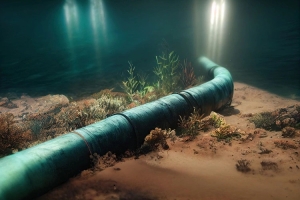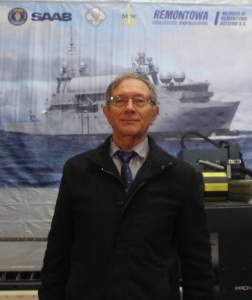Anchor on the cables. Explosions on pipes. The Baltic Sea in danger?

 By Marek Grzybowski
By Marek Grzybowski
Another damage to critical infrastructure in the Baltic Sea sparked a discussion about the security of this region. Threat to ports, cables, pipelines, navigation markings, as well as land infrastructure ensuring navigational safety.
The discussion heated up after the announcement of the launch of an investigation into damage to critical infrastructure in the Baltic Sea. The statement made publicly by the Finnish Minister of European Affairs, Anders Adlercreutz, had a particular impact. He stated that “it is difficult to believe that the sabotage of the undersea gas pipeline was accidental or that it happened without Beijing’s knowledge,” Politico reported in its report on the press conference.
– I’m not a sea captain. However, I think you would notice that you were dragging the anchor behind you for hundreds of kilometers, Adlercreutz said in a statement in Brussels and stated: “I think everything indicates that it was intentional. But of course no one has admitted it yet.”
Gas pipeline with cables in danger
The Balticconnector gas pipeline is an installation worth USD 318 million and 77 km long. It provides Finland with gas supplies from the European gas network. It was put into commercial use in early 2020. Balticconnector operators say it will take at least five months to repair the pipeline and it is unlikely to be put into service before then. This means that the pipeline will reach operational capacity in April 2024 at the earliest.
It is noted that damage to the pipeline will not have a significant impact on Finland’s energy security. Natural gas provides only 5% of energy. Energy from renewable energy sources is growing rapidly in Finland. We wrote about it here.
Energy from nuclear energy is also important. Gas supplies are provided by sea transport to the recently opened liquefied natural gas (LNG) terminal.
Some discussion participants commenting on Adlercreutz’s statement on social media noted that a pipeline should be laid under the seabed in this area of the Baltic Sea. Some experts point out that it was a mistake to lay the pipeline and cables on the seabed on a frequently used route. It should be hidden under the bottom.
Who damaged, who lost, who benefited
As we saw with Nord Stream, the investigation [into the damage to the Balticconnector pipeline] can take a long time, Sari Arho Havren, a fellow at London’s Royal United Services Institute, told RFE/RL. In his opinion, “In the case of Finland, the investigation is progressing very quickly and communication, especially from the National Bureau of Investigation, has indeed been extremely efficient.”
“Regardless of whether this incident was intentional or not, it is something that both Russia and China can benefit from,” Arho Havren said. RFE/RL quotes: “Even though the scale may be small, it once again diverts NATO attention and forces away from other global hotspots.”
An investigation by Finnish authorities quickly identified the Chinese container ship Newnew Polar Bear as the main suspect. It is said that it probably dragged the anchor on the bottom of the Baltic Sea for a long time, cutting cables and damaging the gas pipeline. It was not difficult to determine the culprit because the anchor weighed 6,000. kg were recovered a few meters from the site of damage.
Representatives of the Finnish and Estonian governments contacted Chinese authorities asking for cooperation in the investigation. At the beginning of last week, the Baltic Times reported that both European countries asked Beijing to send representatives to investigate the ship, which has now headed to a Chinese port.
The captain knew, he didn’t tell
The comments were sparked by Adlercreutz’s suggestion, quoted by Politico, that he “cannot speculate on whether this action was approved by the Chinese government. However, the ship’s imminent return to China raises some questions.”
Estonian Defense Minister Hanno Pevkur expressed a similar sentiment last month in an interview with Swedish public broadcaster SVT, saying that the ship’s captain, after dragging the anchor for more than 180 kilometers, certainly “understood that something was wrong.”
More than a year after Nord Stream was damaged as a result of several explosions of gas pipelines connecting Russia with Germany, the Balticconnector incident is raising growing concerns about the safety of critical undersea infrastructure in the Baltic Sea. The situation is even more disturbing because, despite an international investigation, the perpetrator of deliberate damage to Nord Stream has not been identified.
NATO Secretary General Jens Stoltenberg said on October 24 this year that the alliance’s members depend on the functioning of “tens of thousands of kilometers” of undersea internet cables, power cables and pipelines running from the Baltic Sea to the Mediterranean Sea – recalled Reid Standish, RFE/RL correspondent in Prague and author China In Eurasia briefing.
NATO: Infrastructure needs to be given greater protection
“Of course, this type of undersea critical infrastructure is sensitive,” Stoltenberg said, adding that NATO has stepped up patrols in the Baltic Sea and is now working with the private sector, which “owns most of this critical infrastructure,” to better coordinate the response to threats.
– Regardless of whether intentional sabotage is ultimately proven or not, this case will at least increase Finland’s readiness for similar operations in the future, said Arho Havren.
Adlercreutz emphasized at the meeting in Brussels that this type of infrastructure should be provided with “greater protection”. He suggested increasing surveillance of suspicious ships. But he added that there are limits to what can be done.
Incidents in the Baltic Sea and conflicts in the Black and Aegean regions pose new challenges for Poland and the Baltic NATO countries. The problem is not only cyber threats and security related to protecting infrastructure against the forces of nature.
New offshore and port installations, transport systems and energy connections today must take into account the possibility of “accidental” or intentional damage in their designs. Some projects will undoubtedly need to be reworked. We also need to seriously organize comprehensive protection of our infrastructure. Because, as the conflict in the Black Sea shows, any infrastructure may turn out to be critical.
